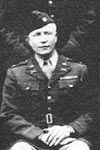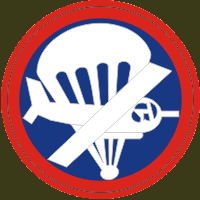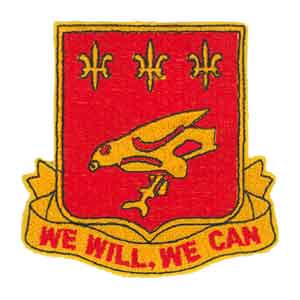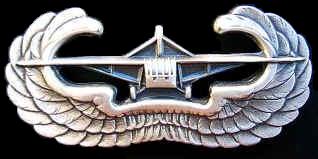|
|
. 907TH GFAB . GLIDER FIELD ARTILLERY BATTALION |
|
The 907th was born under the name of the 307th Ammunition Train constituted in August 5, 1917 at Camp Gordon nearby Atlanta Georgia and assigned to the 82nd Division. It fought for the first time in France during the First War World. It especially took part in the offensive of St Mihiel and the Meuse-Argonne.
It came to an end from the 18th to the 23rd of May, 1919 at Camp Upton New York then reconstituted on June 24th, 1921 like a reserve unit of the 82nd.
On January 1942, the 307th was reassigned as the 907th Glider Field Artillery Battalion GFAB then reactivated two months later, on March 25th, 1942 at Camp Clairborne, Louisiana under the command of Lieutenant Colonel Clarence F. Nelson who supervised the battalion until its dissolution after the war.
 <-Lieutenant Colonel Clarence F. Nelson
<-Lieutenant Colonel Clarence F. Nelson
After its forming at Camp Clairborne, the 907th battalion became an element of the 101st, which moved on August 22, 1943 to New York as it was leaving to England.
As he left on September 4th, the 907th crossed the Atlantic Ocean on the S.S.Strathnaver and landed in Liverpool on October 18th.
It settled its camp in Benham Valence nearby Newbury.
The battalion took part in the Tiger exercise which was carried out in the week from the 23rd to the 30th of April.
![]() D-DAY – June 44 – Normandy – France – Operation Neptune
D-DAY – June 44 – Normandy – France – Operation Neptune
The 907th battalion was on board of the ship which touched a mine in company of a group of the 321st. They had to land on Omaha beaches. They did not lose people during this accident, but they have nevertheless had to wait on June 9th for their guns and their vehicles to be landed on.
A small group of the 907th composed of an officer and 3 men were nevertheless parachuted the day-J.
On June 10th, the 907th was used as the artillery of support with the 502nd PIR nearby St Come du Mont.
The 907th carried on to support the 501st and the 502nd PIR during the first part of the campaign.
On June 26th, the battalion took a position on the west of St Sauveur-le-Vicomte with the 501st then moved towards the south of Cherbourg with what was left of the 101st Division.
On July 10th, 1944, the 101st was replaced and moved back to England.
 Holland – September 1944 – operation Market-Garden
Holland – September 1944 – operation Market-Garden
The 907th battalion was sent to Holland on September 19th (J+2 Day). Unfortunately, only 24 men of a battalion of 550 landed on their zone. The others were spread out because of the fog.
907th would support the 501st PIR in Eerde with their 105 mm howitzers. Just on time, the Germans would attack.
A regiment of 200 Von Der Heydte German Paratroopers attacked Eerde with Panzers. Its church and its windmill were strongly damaged, a truck of ammunition got a direct blow which exploded it, hitting and killing loads of soldiers.
British tanks entered the town but before being able to take a position, they were destroyed. The English command refused to send new tanks as long as the German panzers were not driven out of the dunes.
The B battery carried on defending the positions of the HQ of the 501st while the A battery was keeping its mission of supports of the companies of the 501st. Five times the wire which connected the 501st to the 907th was crossed. Five times some men of the 907th risked their life to repair it under the enemy fire.
Despite its successes, the operation Market Garden was a fiasco on the side of Arnhem. The 907th like all the 101st Division left Holland for Mourmelon in France.
![]() Belgium – December 1944 – Battle of the Bulge
Belgium – December 1944 – Battle of the Bulge
Le 23 février, le 907th est de retour à Mourmelon, en France où la 101st Division reçut du Général Eisenhower, la Distinguished Unit Citation pour sa bravoure à Bastogne.
On the daybreak of December 16th, 1944, the Germans launched a great offensive crossing the Ardennes woods meeting the American defenses ensured by the VII Corps.
The target was to catch Antwerp, the only close port which could provide the Allied troops.
At that very moment, the 01st Division as well as the 82nd is in rest in France and kept as reserve forces.
On December 18th, 1944, the 101st was sent to Bastogne, a strategic city for the Germans because it is on the crossroad of several important roads for their offensive.
The battalion belonged to the forces which pushed back the German attacks.
The supply was also very difficult to get, Lieutenant Colonel Nelson got a 1:100.000 scale map to determine his shootings.
Moreover, the M3ammunition m3 were missing for the 105mm guns.
During this offensive, the 907th was part of the “TEAM Cherry” and supported 5the 01st successfully along the road Neffe-Bizory until the arrival of the tanks belonging to Patton’s 3rd Army 4th division which broke the surrounding.
On January 20, the 907th moved towards Alsace France where the German offensive “Nordwind” was threatening the 7th Army area.
The 321st moved to Davendorf to support the 506th.
On February 23rd, the 907th was back to Mourmelon, France where the 101st Division welcomed general Eisenhower, Distinguished Links Quotation for his bravery in Bastogne.
![]() The
End - 1945
The
End - 1945
As the war in Europe was coming to an end, the 907th moved in the pocket of the Ruhr nearby Neuss on the 2nd of April. Then the unit stationed in Hohenberg, Germany.
907th was dissolved in Germany on November 30th, 1945.
![]() Awards & Decorations
Awards & Decorations
United States :
2 Presidential Distinguished Unit Citations for operations in Normandy and Bastogne
France :
War Cross with palms for the Normandy operation
Belgium :
2 War Crosses and Lanyard for the Bastogne operations
Holland :
Lanyard Oranje from the Netherlands for the operation Market Garden

